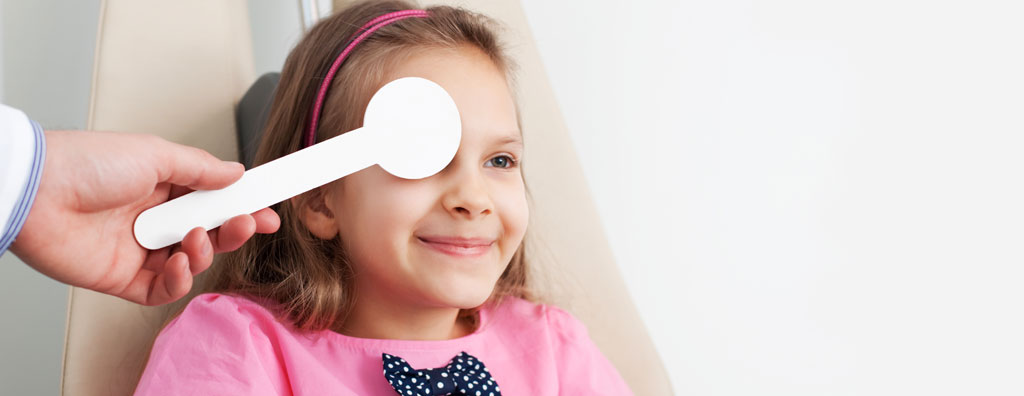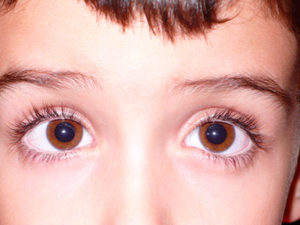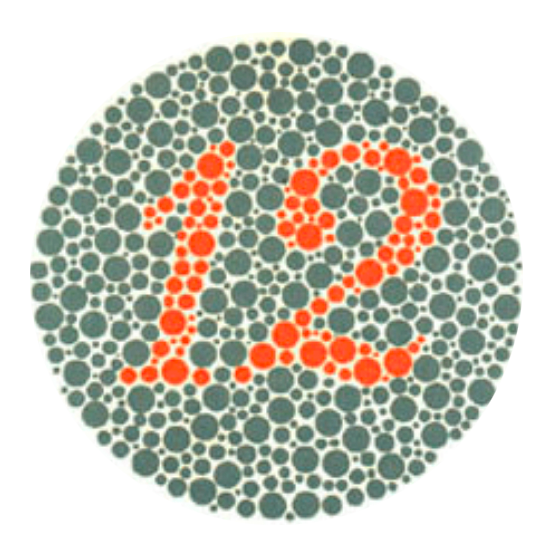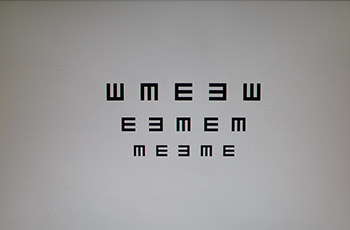
Simple tests to detect possible vision problems. Correct eye problems in time will avoid more complicated issues in the future.
Visual acuity test
Visual acuity evaluates the ability of the visual system to detect and discriminate details of an object. This ability is measured by a specific test with certain parameters (size, contrast, illumination and distance) called Optotype. There are different types that are classified according to the object represented in them: letters, numbers, drawings…
The visual acuity value will be the size of the smallest detail that the patient can distinguish and is measured at a distance of near and far.

Optotype with the drawings of Madame Pigassou.
Test for the evaluation of astigmatism
Astigmatism can be due to several causes; the most frequent is that the cornea is not a sphere with a single radius of curvature, instead of that, it has several. This causes distorted vision at all distances.
The watch test can help us to detect the possible existence of astigmatism.

INSTRUCTIONS
- Stand approximately one meter from the screen.
- If you wear optical compensation, you must put them on.
- Perform the test monocularly, first one eye and then the other one.
- You should look at the figure and determine if there is any line that is sharper or more defined than the others.
EVALUATION
If all lines are equally defined, you do not suffer astigmatism or maybe you are wearing the correct optical compensation.
If you see some lines that are better defined than others, you may suspect astigmatism or you may not have it well compensated by your optical compensation. In this case, it is advisable to visit the ophthalmologist to confirm the diagnosis and the necessary prescription.
Amsler test for retinal evaluation
The Amsler grid test evaluates the existence of macular pathologies (central retina) in a quick and easy way. Thus, any type of alteration of the macula will result in an altered, distorted or deformed image.

INSTRUCTIONS
- Stand about 35 cm away from the test.
- If you wear optical compensation, you must put them on.
- Perform the test with both eyes and then monocularly, first one eye and then the other one.
- Stare at the center point of the grid. The dot should not disappear.
EVALUATION
You must see the edges of the grid clear at all times. Horizontal and vertical lines must not disappear and must retain their parallelism, without undulations or distortions.
Any result different from the expected one or any detected change could be interpreted as a macular alteration. In this case, you should consult your ophthalmologist.
Test for the evaluation of eye alignment
The Hirschberg test is used to evaluate eye alignment and rule out the existence of strabismus. It is very useful in babies or patients who do not collaborate, because is an objective evaluation where we must observe if the reflexes are symmetrical after illuminating both eyes with a flashlight.

Suggestion of self-assessment
We can do this easily, by reviewing photos of ourselves or our family or friends, and see the flash reflections that are seen in both eyes (the points of light). The person should be totally in front of the camera. The reflections should be symmetrical to each other.
In case of doubt, you should consult your ophthalmologist because we could have a case of strabismus.
Test for evaluation of visual field
The field of vision is the area (lateral and frontal) that the eye is able to see the environment when we look straight ahead, without moving the eyes and the head. Having a good field of vision allows us to react in time to dangerous situations.
Do you want to find out how far your field of vision goes?
INSTRUCTIONS
Important: Do not use corrective lenses for this test.
- Take a pencil in your right hand and hold it in front of your face with your arm outstretched.
- Cover your left eye with your left hand. Look straight ahead and maintain this visual direction while slowly moving the pencil to the right with your arm outstretched.
- Stop at the point where the pencil disappears from your field of vision. If you have a normal visual field, your arm should be at a 90° angle from the point of beginning the movement.
- Then, guide your extended arm doing the same as before but on the other side of the body until the pencil disappears from your field of vision. The angle should be about 60°, because the nose limits the visual field.
- Repeat the same procedure, covering your right eye now.
EVALUATION
If you think you are not reaching the specified angle, you should consult your ophthalmologist.
Colour perception test
Color blindness is a vision dysfunction characterized by altered color perception, which can range from confusion between certain shades of green and red, to no chromatic distinction. These defects can be congenital or acquired.
The Ishihara test is the most commonly used test to evaluate if there is an alteration in colour vision.
Currently, to carry out various jobs or to take part in certain competitions, correct colour vision is an essential requirement (firemen, boat drivers, air traffic controllers, public transport drivers, etc…).
INSTRUCTIONS
- The lighting has to be as close as possible to natural light. Avoid reflections.
- Stand 75 cm away from the test.
- The test is performed monocularly.
- You must get it right the numbers you see in each circle in less than 5 seconds.
Below is a link to Ishihara’s test that will help guide you in your color perception.
EVALUATION
The correct result is to distinguish all the numbers. Any error may indicate an alteration in color vision. In this case, you should consult your ophthalmologist.
WHAT DOES THE TEST CONSIST OF?
The Ishihara test is the most widely known test of color blindness in the world. It consists of 38 images called pseudo-isochromatic plates, each showing a number or a few lines. Based on what you can and cannot see, the test provides information about the degree of your red-green vision impairment.
This test can only be used to detect red-green color blindness.
HOW THE TEST WORKS
For each image, you must write the number shown or, in other cases, choose the number of lines you can see (0, 1, 2). If you don’t see anything, just leave the input field empty.

Test to detect vision problems in your children
With this small questionnaire you will be able to detect vision problems in your children. If the answer to these questions is YES, we recommend that you go to the ophthalmologist:
- Your child sits very close to the television or brings the paper very close to read or write.
- They blink frequently or always wink one eye.
- They squint in order to see.
- They twist their head when they want to fix their gaze.
- They suffer from headaches.
- There is a notable difference in the vision of one eye compared with the other.
- Their eyes are frequently red.
- Their eyes regularly have styes or peeling skin near the eyelashes.
- They have crossed eyes (strabismus).
- You have a family history of eye problems.
- Your child’s pupils look white.
- Your child has trouble reading and writing.
Retinoscopy using animated films or "retinofilms"
This is a cover test used to make a child pay attention to a fixed faraway point during a retinoscopy. The aim is to monitor the patient’s ocular accommodation (focus) during the objective refraction test. Cartoon videos help hold the children’s attention during the test. They include numbers and letters in the centre of the image and they are accompanied by music.





